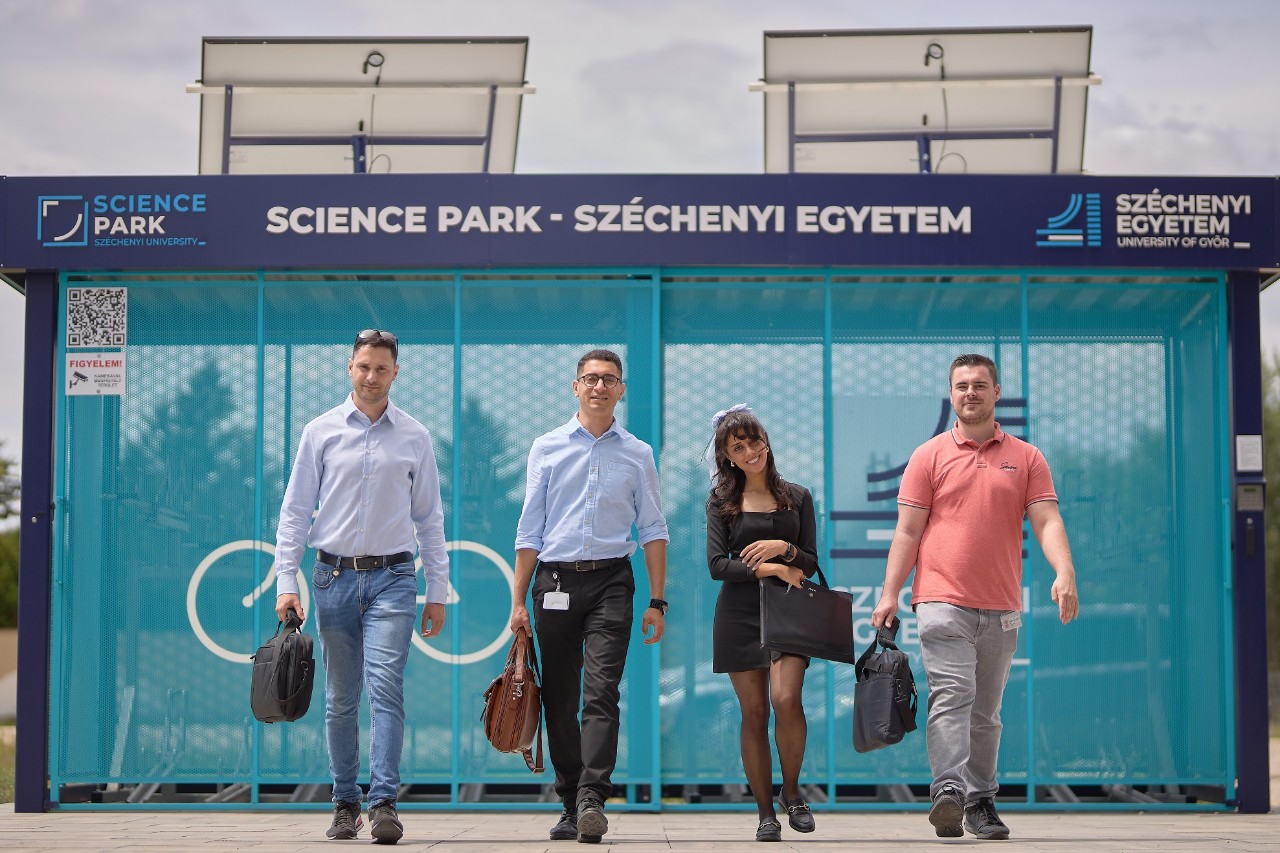It would have been difficult to arrange a more international interview than this on the fifth floor of the Science and Innovation Park on the site of the old biscuit factory in Győr, where we spoke with the team members of the HIL-model from Audi Hungaria Vehicle Development, including Amro Khaled, Hana Salameh, Gergő Puter and József Lennert.

Hana, who is from Jordan, graduated from the University of Debrecen with a master’s degree in mechatronics, and then joined Audi Hungaria’s development engineering team through the Audi Development Camp, like Amro, who also found his way to his current position at the four-circle company through the company’s summer camp, organized every summer with the Széchenyi István University. The Hungarian members, Gergő and Józsi, became Audi employees straight from Széchenyi István University. While Gergő started as an intern at the Experimental Powertrain Manufacturing Center (MAC) in 2021, Józsi started as a dual student the Department of Internal Combustion Engines and Propulsion in 2022, both of them took over the red jacket from the Arrabona Racing Team. Although they come from different places, they all have several things in common: they are young, proactive, with a thirst for knowledge and a desire to do something.
What does your team do within the vehicle development?
Józsi and Gergő: Our international team of 14 people is engaged in real-time computer modelling and testing: we are currently developing a virtual vehicle for AUDI AG, for which we are testing various components using simulations, explain Józsi and Gergő, who take turns to welcome us in their office on the fifth floor of the Kocka building.
Hana: At the vehicle development, our main priority is the continuous development of future models for production. Before these vehicles reach the further steps of development, they have to go through several simulation phases, including Model-in-the-Loop (MiL), Software-in-the-Loop (SiL), Hardware-in-the-Loop (HiL) simulations, and finally, testing with a reference vehicle.
Amro: I am working with Hana on the development of the virtual driver, which allows us to run the vehicle model in a simulated environment, as well as to test and evaluate its performance in a wide range of scenarios. Therefore, even before it goes into the production phase, we carry out a full-scale inspection and optimization regarding performance and safety.

Why is virtual testing important for vehicle development activities? What are the benefits of the Hardware-in-the-Loop (HiL) simulation?
Gergő: Testing the hardware/software in the vehicle is extremely time-consuming and expensive. Our virtual tests can be replayed several times, under any conditions, so control units can be better analyzed. Even if the vehicle is still in the initial development phase, we already have the opportunity to test and optimise functions/different scenarios.
Józsi: This helps to detect errors earlier, allowing the development cycle time to be shortened and optimized.

What competences are essential for your job?
Hana: I would definitely highlight technical skills. Whether it’s understanding mathematical concepts, using sophisticated software tools or keeping up to date with the latest industry technologies, having excellent technical skills is essential. Another key competence, in my opinion, is teamwork and communication.
The boys agree with this, as everyone in the team has their own coordinated tasks that are synthesized at the end of the project work. It is not uncommon for them to communicate with each other, suppliers and AG colleagues in three different languages. Moreover, critical thinking, problem-solving, programming and modelling skills are also highly valued.

We are at a special place, how did you end up as an Audi employee in the center of Győr, in the Kocka building?
Józsi: In reality, the testing equipment itself is mainly located in Ingolstadt, but we also have two whole vehicle HiL simulation and 4 component HiLs at the Audi Hungaria site in Győr. Since we work in a simulated environment, we need our laptop as a tool for our work. So the focus has been on being in an inspiring, international environment where we can also exploit synergies with academic life. Here at Kocka, we share an office with the staff of Széchenyi István University, five of whom form the so-called Core Team, who carry out certain tasks for us, while six doctoral students and postdocs form the Innovation Team. We work with them in a long-term partnership, they will be developing process optimization innovations for us, while introducing and promoting our field to university students.

How does this special location add value to your work?
Gergő: It makes communication with the university team easier as information flow is faster. At Audi, we work partly in the factory and partly in Kocka.
Hana: The environment here is highly ergonomic – automatic climate control, adjustable lighting system, noise filtration – so we can work efficiently. I think that creativity requires a change of scenery from time to time, so this breathtaking natural view of the Püspökerdő and the confluence of the Mosoni-Duna and the Rába provides a calm and inspiring backdrop for our work.
Amro: The proximity of the university really allows us to make better use of the synergies between industry and science, and to better involve colleagues from the university in our projects. These dynamic relationships bring more input and creativity, which is essential for being successful at work.

Finally, we were curious to know what our young colleagues like to do in a building that is not only valuable for its scientific aspects, but also very modern and unique in its design. Although there is a broad consensus on all issues within the team, at this question they all smiled and mentioned the top-floor terrace, where they can recharge with stunning natural views.

